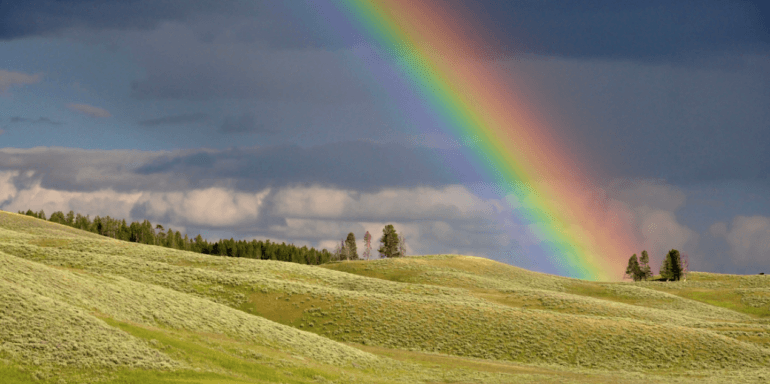
What Is The Meaning Behind Rainbows In The Torah?
Dear Jew in the City-
Many people enjoy looking at rainbows. I know it’s meant to be considered a sign that we are supposed to repent. Are we allowed to enjoy them (or tell others about them)?
Thanks,
Darcy
Dear Darcy-
Thanks for your question. The rainbow is the topic of Genesis 9:12-16, following Noah’s departure from the ark. These verses explain that the rainbow – which appears after a rainstorm – is the sign of God’s promise that He’ll never again destroy the world through a flood.
Rashi on Genesis 9:14 explains that the rainbow recalls God’s anger and His desire to destroy the world because of our misdeeds. In that understanding, a rainbow is not a particularly fortuitous sign; it’s basically God saying, “I really should destroy you but I promised not to.”
A rainbow is a not a bow like a hair ribbon; it’s a bow as in “bow and arrow.” The Ramban (Nachmanides) explains that God is pointing his bow away from us as a sign that He’s not going to shoot His metaphorical arrows at mankind.
The mishna (Avos 5:6) lists the rainbow among the ten things that God created at twilight on the last day of creation. (Other things created at this time include the “mouth” of the earth that swallowed Korach and his followers, the ability of Balaam’s donkey to speak, and Moshe’s staff.) There is, however, a difference of opinion as to whether the rainbow only first appeared after the flood or whether they were always seen but only designated a sign after the flood. (The consensus seems to support the latter opinion. See ibn Ezra on Gen. 9:13 and Ramban on Gen. 9:12.)
We recite brachos upon experiencing a number of natural phenomena, such as hearing thunder or seeing the ocean. Similarly, upon seeing a rainbow, we recite the bracha zocheir habris neeman b’vriso v’kayam b’maamaro, that God remembers the covenant, He is faithful in His covenant and He keeps His word (not to destroy us with another flood).
There is a difference of opinion as to whether one must see the entire arc of a rainbow in order to recite the bracha or whether seeing part of it is sufficient. Some authorities invoke the principle of safeik brachos l’hakeil, i.e., when in doubt about a bracha, we act leniently and don’t recite it. Others say that there’s sufficient precedent to justify reciting the bracha on seeing a partial rainbow. Readers are advised to consult their own rabbis for guidance in this matter.
The bracha is recited only once per rainbow; one may recite the blessing upon seeing a different rainbow on that same day. The bracha is only recited on a rainbow that forms in the sky; if you see a rainbow in a puddle, you would not recite a bracha. The bracha may be recited upon viewing a rainbow through a window. It is preferable to recite the bracha while standing.
The Ben Ish Chai quotes the Ya’aros D’vash that there are two types of rainbows – the regular kind and one that has a blue tint. He opines that only that bluish rainbow recalls God’s promise not to destroy us with another flood. According to his understanding, one would recite the bracha without God’s Name upon seeing a normal rainbow.
The Talmud (Chagigah 16a) tells us that one who stares at a rainbow will cause his vision to dim. It would have been better for such a person not to be created (the Talmud says) because he cares little for God’s honor. This is based on Ezekiel 1:28: “Like the appearance of a rainbow in the clouds on a rainy day, so was the appearance of the radiance all around. This was the appearance of the likeness of the glory of God.” Since the prophet compares his vision of God’s glory to a rainbow, it is prohibited to stare at a rainbow out of respect for God. One may, however, look at it briefly in order to recite the bracha.
The Mishnah Brurah (229:1) cites the Chayei Adam that one shouldn’t inform others about a rainbow because doing so is considered sharing bad news. Other authorities disagree and maintain that one should always inform others of the opportunity to recite a bracha, including pointing out a rainbow. Rav Ovadiah Yoseif ztz”l maintained that the appearance of a rainbow is an inherently positive occurrence, given that it means that God isn’t going to destroy the world. Nevertheless, the normative practice (at least among Ashkenazim) is not to inform others. (Sefardim should consult their own rabbis as far as which opinion to follow.)
So that’s the long and short of rainbows. We’re allowed to look at them in order to recite the bracha, and we should certainly appreciate what they represent, but we’re not allowed to stare at them or to inform others of them. (Those Sefardim who generally follow the rulings of Rav Ovadiah Yoseif might inform others; again, ask your own rabbi for guidance.)
Sincerely,
Rabbi Jack Abramowitz
Educational Correspondent
Follow Ask Rabbi Jack on YouTube
If you found this content meaningful and want to help further our mission through our Keter, Makom, and Tikun branches, please consider becoming a Change Maker today.







